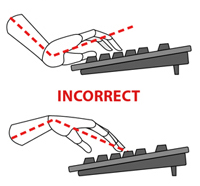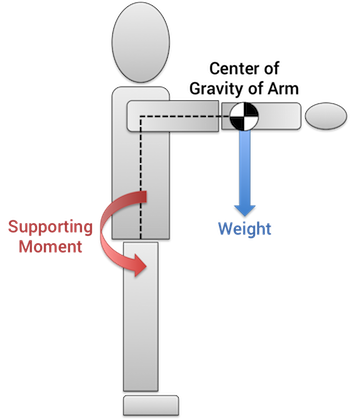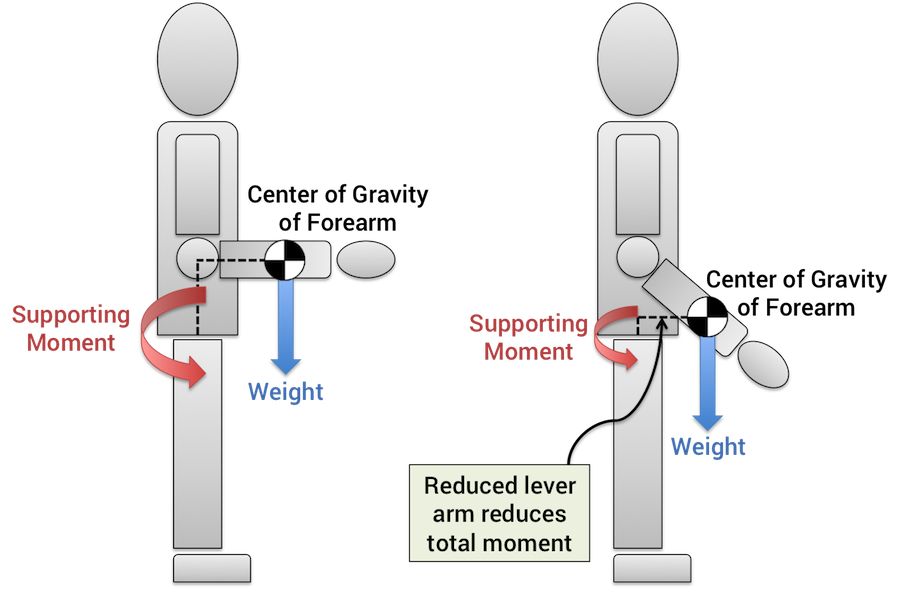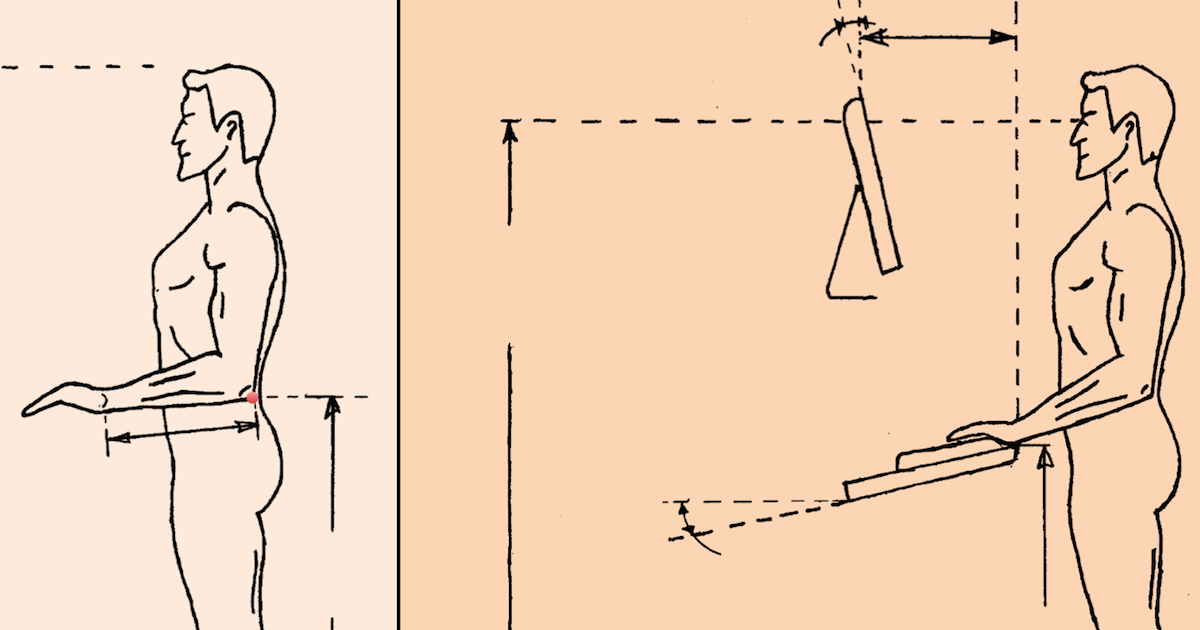
Explained below. [img credit]
Let’s start with why that bad advice is so common.
It’s because desks are flat.
If you assume the desk is flat, holding your elbows at 90 degrees is the right answer, because anything else causes a serious problem.
At a flat desk, if you hold your elbows at a tighter angle (less than 90 degrees), your wrist has bend back to reach your keyboard, causing pain and fatigue, and increasing the risk of carpal tunnel syndrome. If you open your elbow join beyond 90 degrees, your wrists still take the burden, this time bending upward and placing unnatural stress on your palms.
So we agree with the advice IF the desk has to be flat.
The Downside of 90 Degree Elbows
When you’re standing up, your posterior chain (back) muscles have to be in balance with your anterior chain (front) muscles to maintain balance. With no real load applied, this is pretty easy to achieve, and all is right with your body. Try standing up straight with your arms at your sides. You can barely tell that your muscles are working to keep you standing up, because the are in a good balance.
Now reach your hands out in front of your body at shoulder height. Did you feel your back muscles kick on to keep you from falling forward? In this state, the weight of your arms is increasing the moment about your hips that your posterior chain muscles have to support.

The weight of your extended arms forces your back muscles to provide a supporting moment.
Now your back muscles are working harder than your front muscles, so your body is out of balance. It’s not bad with just the weight of your arms for a few seconds, but increase the load or duration and it become clear how unsustainable this situation is. Could you hold your arms up and out like that for an hour?
Even if you can, you shouldn’t. Spending a long period of time with your posterior and anterior chains loaded unevenly sets you up for a world of hurt, fatigue, and increased likelihood of injury.
When people recommend that you work at your standing desk with your elbows at 90 degrees, the weight of your forearms is loading your back muscles in this same unnatural, unhealthy way.
Reducing the Uneven Load with Simple Physics
Holding your arms out forces your back muscles to activate to counteract the moment created by the weight of your arms. In physics, moment equals weight times distance. We can’t very well reduce the weight of your forearms, so let’s reduce the distance they are from your body.
Since your forearms are connected to your elbows, the only way to get them closer to your body is to swing them up or down. Up is out, because it causes uncool loading in your upper arm and shoulder. Down is the answer.
But down was ruled out earlier, right? Because it forces your wrists to bend upward? That was for flat desks. Enter the last piece of the puzzle.
Negative Tilt Keyboards Save Your Back and Shoulders

Opening your elbow angle moves the weight of your arms closer to your body, reducing the moment supported by your back muscles. (click image to enlarge)
If we angle your keyboard away from you, you can now keep your forearms closer to your body without compromising your wrist alignment.
When you tilt your keyboard back and work with your elbows more open, you’ll be placing a reduced load on your back and shoulder muscles. This simple modification to your standing desk setup reduces the fatigue and likelihood of injury that flat desks force upon you.
That’s why when we broke down the best standing desk options, we recommended the Ergotron WorkFit-S, because it’s one of only a handful of solutions on the market that allows for a negative tilt keyboard. And negative-tilt keyboards are the best you can do for your health.
At least until someone makes a keyboard that hangs on your pants!
Biomechanics Shows Negative-Tilt Keyboards Even More Important
Here’s a gem of a quote from a USC lecture:
A human arm has 7 DOF (3 in the shoulder, 1 in the elbow, 3 in the wrist), all of which can be controlled. A free object in 3D space (e.g., the hand, the finger tip) can have at most 6 DOF! So there are redundant ways of putting the hand at a particular position in 3D space.
That’s a lot to understand if you’re not big on physics. What it boils down to is that there are arm positions which your muscles have to fight each other to maintain.
We posit that this is another major problem with holding your elbows at 90 degrees.
Let your hands hang at your sides. Now lift your hands as high as you can get them without moving your elbows. Did you notice your elbows being pulled away from your torso, out sideways? We think that’s evidence of the over-constrained biomechanics in this system.
So it’s likely that the unnatural loading the shoulder experiences from holding your arms up at 90 degrees is due to both the moment loading addressed above and your muscles fighting each other for control.
One more reason to use a dropped, negative-tilt keyboard.
The post Why You Don’t Want Your Arms at 90 Degrees at a Standing Desk appeared first on Quitting Sitting.




















